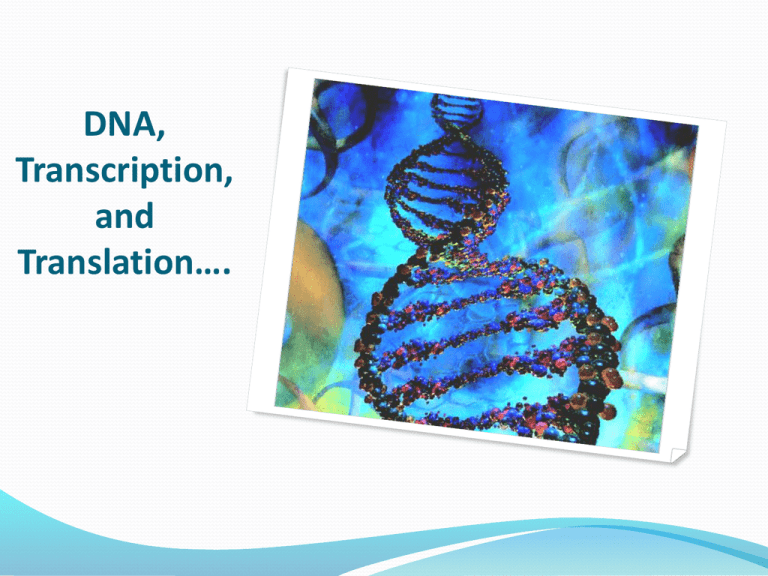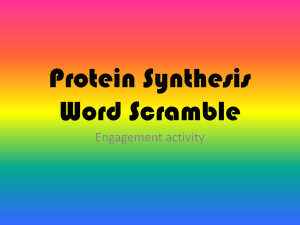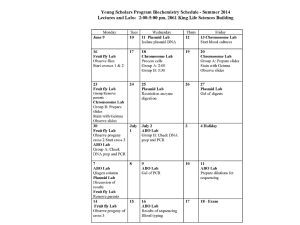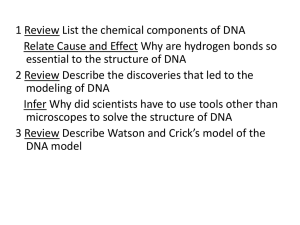
DNA,
Transcription,
and
Translation….
Why Should We Learn About DNA?
To understand how genes are inherited and expressed.
To understand the evolution of the Earth’s diversity
and protect it.
To understand the relationships between species.
To understand the many uses of DNA technology –
like DNA fingerprinting, cloning, and gene therapy.
And.... Because I said so.
I.
DNA Molecule of Heredity
A. Structure
DNA is a double
helix– two strands
twisted around
each other, like a
winding staircase
The DNA molecule
is made up of
Nucleotides.
I.
DNA Molecule of Heredity
A. Structure
DNA (polymer) is a long molecule made up of Nucleotides
(monomers)
A Nucleotide consists of:
Deoxyribose (a 5-carbon sugar)
a phosphate group
One of 4 Nitrogenous bases (contain nitrogen)
Adenine (A)
Guanine (G)
Cytosine (C)
Thymine (T)
PURINES
PYRIMIDINES
The Deoxyribose and the Phosphate group are always the
same, but the nitrogen base has 4 different possibilities
B. Chargaff’s Rules:
1. CHARGAFF (1949):
discovered that the % of Cytosine
and Guanine were about the
same in DNA; the same was
true about Adenine and
Thymine
This suggests BASE
PAIRING……….. that the
amount of A in any DNA
sample always equals the
amount of T in the
sample.
A= T and G=C
Sour
ce of
DNA
A
T
G
C
Strep 29.8 31.6 20.5 18.0
tococ
cus
Yeast 31.3 32.9 18.7 17.1
Herr 27.8 27.5 22.2 22.6
ing
Hum 30.9 29.4 19.9 19.8
an
History (cont.)
2. Wilkins and
Franklin(1952): took X-Ray
photographs of DNA which
suggested a twisted, helical
structure, 2 strands, and bases in
the center
3. Watson and Crick (1953):
using all the research to date,
created a model of DNA
structure:
Their model was a Double Helix
with 2 of nucleotides that had
their bases facing each other (like
rungs of a ladder)
C. DNA Replication: Copying DNA
Making more DNA during the S Phase of the Cell
Cycle (in the nucleus)
1. The Enzymes (Helicase) “unzip” and unwind the
double helix to break the nitrogen bonds.
2. DNA Polymerase ( an enzyme) moves along the two
(2 )strands and pairs complementary bases to the
exposed nitrogen bases.
3. DNA Polymerase remains attached until 2 new DNA
strands are created; it “proofreads” the strands to
minimize error in the process.
4. Mutagens – Things in the environment that can
change the structure of DNA.
DNA Replication (cont.)
Diagram of DNA Replication:
http://www.johnkyrk.com/DNAreplication.html
II.
From Genes (DNA) to Proteins
RNA: Ribonucleic Acid;
• Made from DNA blueprint
• Used to determine the order of the Amino Acids
• Single-stranded
• RNA (polymer) made of nucleotides (monomer):
-Ribose = 5 C sugar + Phosphate group + N Base
4 bases: Cytosine (C),Guanine (G),
Adenine (A),Uracil (U) –
In RNA there is NO THYMINE;
it is replaced by Uracil (U).
So, any (A) in strand will
bind with (U) in RNA
( instead of a T if it was binding
with another strand of DNA)
B. Gene Expressions:
Protein Synthesis: Using genetic information in
DNA to Make Proteins
1)
2)
2 Stages in making proteins:
Transcription – using DNA template to make mRNA
strand (an RNA copy is made from a gene)
Translation – using mRNA strands to create
polypeptides (RNA work together to assemble Amino
Acids into a protein).
DNA
Transcription
RNA
Translation
Protein
Central Ideas:
DNA has the instuctions for the order of the
Amino Acids which make up the Proteins that
make up the traits of any organism.
DNA
RNA
Proteins
Transcription:
Basically, the DNA is kept safe in the nucleus while the RNA is
sent out to the cytoplasm to direct the synthesis of proteins.
Transcription:
How it’s done: (This happens in the Nucleus!)
1. Transcription begins with Helicase (another enzyme)
binding to a region of DNA called a promoter, and
then unwinding the double helix and separating a
section of the 2 DNA strands
2. RNA polymerase then moves along one strand of the
separate DNA like a train on a track, binding
complementary RNA nucleotides to the exposed DNA
strand. This occurs until a specific “code” sequence is
reached.
Transcription (cont.)
Transcription (cont.)
3. Once produced, the RNA polymerase
then detaches from the DNA and
floats free.
4. This process forms a single strand of
Messenger RNA (mRNA)—a form of
RNA that carries the code for making
proteins from a gene and delivers it to
the site of translation (the ribosomes)
5. The mRNA passes out of the nucleus
and into the cytoplasm of the cell for
translation to begin.
6. Lastly, the two (2) DNA strands
rejoin.
The Genetic Code
1.
Codon – every 3 nucleotides in mRNA that specify a
particular amino acid
a.
b.
The order of the bases (letters) in a codon determines
which amino acid will be added to the protein that is
being built
The order of the amino acids determines which
protein is made!!
More genetic code
2.
Genetic code – the amino acids and “start” and
“stop” signals that are coded for by each of the
possible mRNA codons.
Codons in mRNA
“Start” codon = AUG (Methionine)
“Stop” codons = UAA, UAG, and UGA
Example:
mRNA Strand:
U-C-A-U-G-G-G-C-A-C-A-U-G-C-U-U-U-U-G-A-G
methionine glycine
threonine cysteine phenylalanine STOP
Genetic code table
a.
Example: decode the following mRNA
CUG AUU UUU GCA GAC GAG UAU UGA
GAC UAA AAA CGU CUG CUC AUA ACU
Practice!
DNA
mRNA
codon
Amino Acid
ATC
UAG
Stop!
TAC
AUG
Start –
Methionine
GAT
CUA
Leucine
CCG
GGC
Glycine
3. Translation
The Goal of Translation is to “translate” these
mRNA codons into their amino acids to form a
polypeptide.
How it’s done:
1. mRNA strand attaches to a ribosome (rRNA)
2. Each mRNA codon passes through ribosome
3. Free-floating Amino Acids from cytosol are brought to
ribosome by tRNA
4. Each tRNA has an anticodon to match up to mRNA
codons
5. Amino Acids are joined as tRNA keeps bringing them
6. Polypeptide chain grows until “stop” codon is reached
Translation (cont.)
Translation
Mutations
Mutations – a change in the DNA of a gene
C.
1.
any change in the DNA code can result in the wrong
amino acid being put in when the protein is being
built; even one wrong amino acid is enough to disrupt
the protein’s function
Types of mutations
a.
b.
c.
d.
Point mutation – a single nucleotide changes
Insertion – a chunk of DNA is inserted into a gene
(often the result of transposons)
Deletion – segments of a gene are lost
Transposition - 2 genes switch places with each
other
Chromosomal Mutations
Types of mutations
Frameshift – any mutation that causes a gene to be
read in the wrong 3-nucleotide sequence
e.
i.
ii.
Frameshifts are usually the result of insertions or
deletions (even if it is only one or two nucleotides)
Example: THE CAT ATE
THE ATA TE
Causes of Mutations
Internal
Mistakes in DNA replication
External
Radiation, chemicals, high temps
Mutagens: chemicals that cause mut.
Mutations in body cells only affect that person
Mutations in sex cells can be passed to offspring
population








